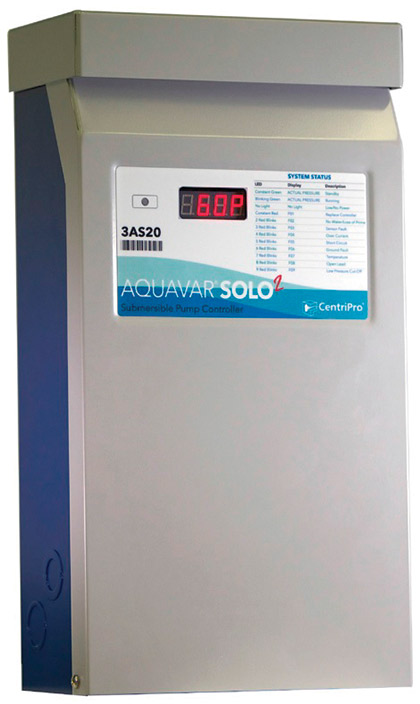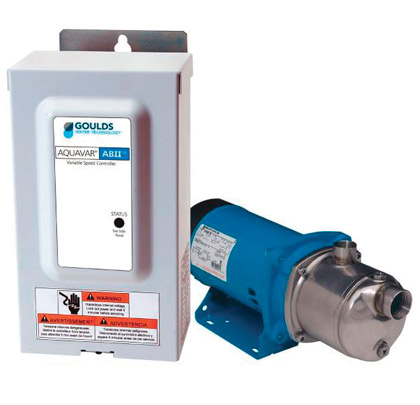According to the United States Environmental Protection Agency, the average American family uses more than 300 gallons of water per day. Nearly 70 percent of daily water use occurs indoors, and nearly half of the indoor water consumed is used to do household chores like running the dishwasher and doing laundry.
Often, these chores are taking place at the same time, which can result in a drop in water pressure. Many homeowners don’t know how to fix their water pressure fluctuations and turn to professional dealers or installers for the answer. A variable frequency drive is an effective and dependable solution.
VFD USE IN HOUSEHOLDS
A variable frequency drive is a type of controller that monitors household water demand. The drive speeds up or slows down the pump depending on the household water requirements to deliver constant water pressure where and when it’s needed.
In addition to ensuring consistent water pressure, a variable frequency drive offers other benefits.
- It extends equipment life. A variable frequency drive protects the motor and pump in a water system from running dry, over current, short-circuiting, and ground fault.
- It eliminates the need for energy-guzzling appliances. Installing a variable frequency drive is a cost-efficient alternative to control valves and outlet dampers that use large amounts of energy to run.
- It minimizes mechanical and electrical stress. A variable frequency drive features a soft-start capability that gradually ramps up the motor to operating speed. This soft-start feature greatly reduces stress on system components.
The drive can be installed in a new water system or retrofitted for an existing water system. Variable speed drives are available with single-phase or three-phase motors.
Before installing the drive, it is important to note that some variable frequency drive models have a maximum frequency switch, which is used to energize the motor to be either 60 or 80 Hertz (Hz). Use 60 Hz for match-pump motor combinations where the motor and pump horsepower are the same. For mismatched pump and motor combinations, where the motor horsepower is larger than the pump horsepower (typically two times larger), set the motor to 80 Hz.
INSTALLING A VARIABLE FREQUENCY DRIVE IN A NEW SYSTEM
The first step is to properly size the water pump, taking into consideration well depth, demand, and recovery rate. Some manufacturers have online selection tools for installers to aid in choosing the proper pump model.
Once you have selected the variable frequency drive, and the electrical power has been shut down, professional installers should follow these five steps for installation:
- Hook up incoming power per the manufacturer’s instructions.
- Connect output power to the well. The wires will be color-coded, and the number of wires will depend on whether you are working with a single-phase motor or a three-phase motor. If a three-phase motor is being installed, make sure the motor is running in the proper counter clock wise rotation.
- Install the transducer. A transducer is the control for the drive and measures the pressure in the system.
- Adjust tank pressure. A new tank will typically be set at 38 pounds per square inch (psi). The rule of thumb is for a 20-psi differential between the set pressure and the tank pressure. For example, if your set pressure is 60 psi, the tank should be set at 40 psi. It is recommended that tank pressure be set at 30 psi for new installations—note that the tank must be empty when setting the pressure.
- Adjust the motor overload setting dial to match the motor’s service factor amps.
When the service factor amps are unknown, open the multiple fixtures/faucets at the same time and measure the output current with an amp meter to determine the current load. - Failure to adjust the motor overload setting dial may damage the motor or wire. This will also void the product warranty.

Featured Images: A “constant pressure system” operates with a home’s well pump and a variable frequency drive controller to automatically monitor household water demand. The Aquavar Solo2 constant pressure controller provides reliable consistent water pressure, regardless of water consumption.
Above: The Aquavar ABII series works in conjunction with municipal water system. As water use increases, the Aquavar ABII changes pump speed to keep line pressure constant.
RETROFIT INSTALLATIONS
Most retrofit installations will be single-phase output, as the drive must match the system.
Before beginning the installation, make sure all water has been drained from the system. If there is water in the tank, the pressure reading will be inaccurate and can cause cycling issues. Also, be sure to check the motor installation and wiring resistance to make sure that the motor and wire are in good condition.
After selecting the proper variable frequency drive, follow directions for input and output wiring. When installing the transducer, disconnect the pressure switch from the pipe (tank tee). If there is an additional port, you can reconnect the pressure switch. If not, connect the transducer in the port where the pressure switch was located. After adjusting tank pressure and current overload, you are ready to start the system.
IMPROVING QUALITY OF LIFE
For a rural Wisconsin homeowner, the water pressure fluctuations from the well to her home created some challenges for family life with three children. If more than one water source was activated, water pressure slowed to a trickle. “That’s not good if you’re in the one in the shower with a headful of shampoo,” she says.
She and her husband contacted a professional contractor to retrofit the system with a variable frequency drive. “The retrofit installation is life altering,” she says. The shower, dishwasher, and laundry can now run simultaneously without experiencing a drop in water pressure.
THE NEED FOR PROFESSIONAL INSTALLERS
Installing a variable frequency drive is not a do-it-yourself project. If it is not properly installed, the motor and pump will operate in adverse conditions, causing additional system damage or nuisance faults. This can cause the system to be inoperable and leave homeowners with no water.
Many contractors, dealers, and installers will not honor the product warranty if a homeowner installs a variable frequency drive in a water system.
Professional contractors are typically licensed, certified, and educated on installation and the latest technologies. Some belong to professional associations that focus on providing them with the education they need to stay current on the latest technologies, products, and industry trends. Some product manufacturers also offer ongoing training to professional contractors. Dealers and water treatment professionals who become certified to install this equipment provide a valuable service to their clients. ◆
About The Author
Chris Preston is a residential water product manager with expertise in submersible and jet pumps and residential pumping systems. For more than 10 years, he has worked for Xylem Inc. and its Goulds Water Technology brand as a product design engineer and project manager on multiple global new product development projects. Preston holds a bachelor of science degree in mechanical engineering from Clarkson University.
____________________________________________
MODERN PUMPING TODAY, December 2015
Did you enjoy this article?
Subscribe to the FREE Digital Edition of Modern Pumping Today Magazine!
![]()


